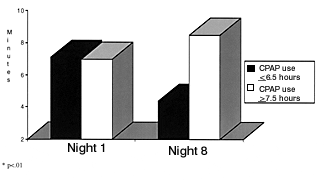Be aware of the safety and legal risks of fatigue and alertness management in the sleep laboratory.

When she finally leaves the hospital to drive home, it is the middle of her habitual sleep time. Out of habit, she turns on the car radio, listening for news about Iraq, where her son has just completed a tour of duty. She has spent many sleepless nights worrying about him. Now that he is out of harm’s way, she can finally relax.
The next instant, she is asleep at the wheel. Her car veers into oncoming traffic and collides with another vehicle. The woman survives, but the two people in the other vehicle are killed in the accident.

This woman chose to drive when she knew she was sleepy. As a sleep technologist, she was obviously aware of the dangers of sleepy driving. Her decision to drive while drowsy went against the implicit code of conduct shared by all sleep specialists. It contradicted her role as a sleep technologist and all of her valuable work in helping patients with sleep disorders. The car accident and resulting deaths were undoubtedly her own fault. But does her employer share some of the blame?
This fictional scenario is modeled on a recent legal case in which a nurse and the hospital that employed her were both found culpable in two deaths resulting from a motor vehicle accident.1 The accident occurred because the nurse fell asleep at the wheel after working a 12-hour night shift followed by a hospital-required training session. In 2003, a California appeals court concurred with a lower court’s opinion that the accident was caused by reckless behavior on the part of both the nurse and her employer. The hospital was found liable for 25% of the accident because the required training scheduled after the night shift constituted a “special errand” under which the usual rules that protect hospitals from this kind of liability did not apply. Ultimately, the decedents’ estates were awarded nearly $1.4 million in damages, which came mostly from the hospital, based on the ability to pay.
| Ten Things You Can Do to Prevent Sleep-related Accidents
1. First and foremost: Never drive while sleepy! Always pull over at the first sign of drowsiness. |
This case is indicative of a legal trend that has been actively encouraged by the sleep community’s tireless efforts to address the dangers of sleepiness. By way of example, the National Sleep Foundation took a leading role in applauding New Jersey’s enactment of the first law in the country that explicitly defines drowsy driving as criminal recklessness.2 Known as Maggie’s Law, it was named after a young woman who was killed in a motor vehicle accident caused by a sleepy driver. The law came into existence in 2003 because of public outrage at the light sentence the driver received after his lawyer successfully argued that there was no specific law against falling asleep while driving. The passage of Maggie’s Law can be seen, in part, as evidence of the success that the sleep community has had in raising public awareness of the hazards of sleepiness.
By now, everyone should know that driving while excessively tired is reckless and dangerous. Multiple studies have consistently shown that sleepiness is comparable to drunkenness in its effects on performance and driving.3 Experts now consider sleepiness to be the most common identifiable and preventable cause of transportation accidents—more than alcohol and drugs combined.4 Sleep specialists work day and night combating the problem of sleepiness by caring for patients with sleep disorders. But how well do we manage the sleepiness in our own midst?
Sleepiness in the Sleep Laboratory
A random survey of 238 members of the Association of Polysomnographic Technologists (APT) showed that excessive sleepiness is common among sleep laboratory staff.5 It found that about one third of all sleep laboratory personnel are excessively sleepy as defined by an Epworth score of >9. Most alarmingly, it determined that 30% of sleep laboratory staff tended to agree with the statement, “In the past year did you catch yourself nodding off while driving to or from work?” In fact, six individuals admitted, “Definitely yes.”
The APT survey showed that the night shift was associated with increased sleepiness, decreased total sleep time, and diminished sleep quality when compared to the day shift. The proportion of day and night shift workers with excessive sleepiness was equal to that of the general population.6 These findings corroborate research in other shift work settings and illustrate some of the reasons why working the night shift is known to increase the risk of accidents.
The APT survey also showed that 12-hour night shifts are extremely common in the sleep laboratory, while 8-hour night shifts are rare. This finding is worrisome in light of other research showing that night shift-related elevations in sleepiness, performance errors, and accidents tended to rise even higher when the night shift was long in duration.7 Though difficult to prove, the long duration of night shifts observed in most sleep laboratories most likely increases the risk of sleep-related accidents.
Clearly, excessive sleepiness is as epidemic among sleep specialists as well as in society. It is probably just a matter of time before we start seeing headlines and lawsuits arising from sleep-related accidents caused by sleep specialists, but there are many things we can do individually and collectively to prevent these accidents from occurring.
Fatigue and Alertness Management Policies
Of all of the suggestions provided, the only one that is solely the employer’s responsibility is the adoption of a Fatigue and Alertness Management Policy (FAMP).8,9 The primary reason for implementing a FAMP is not to protect against legal liability, but to decrease risk of fatigue-related accidents. Though a FAMP cannot prevent a lawsuit, it can demonstrate that the employer takes the risk of sleep-related accidents seriously and has taken steps to manage that risk.
A FAMP communicates the employer’s expectation that all employees maintain alertness at work and while driving. It recognizes both the necessity of shift work and the increased risks associated with it. To deal with those risks, a staffing plan is identified that addresses specific issues such as shift length, overtime, adequate staffing, and opportunities for breaks. For example, a FAMP acknowledges that sometimes the best solution for staff shortages is the cancellation of patient appointments.
A FAMP should detail a staff education program with competencies that demonstrate the understanding of key concepts including sleepiness, sleep debt, circadian rhythms, and the impact of shift work, while stressing the high risk of sleepiness while driving. Additionally, employees should be encouraged to raise concerns about fatigue and alertness not only in staff meetings, but among themselves. After all, the tragedy described at the beginning of this article may not have unfolded if coworkers had simply intervened. To modify a catch phrase from a similar public education campaign, “Friends don’t let friends drive drowsy.”
Conclusion
All sleep specialists share a collective mission of serving individuals and society by identifying and treating sleep disorders. Driving while sleepy or creating a work schedule that increases sleepiness to dangerously high levels is in direct conflict with this mission. It is not credible for sleep specialists to deny their knowledge of the risks of sleepy driving or the increased risks of sleepiness associated with shift work. Given the safety and legal risks associated with sleepiness, it is time for every sleep specialist to take responsibility for his or her alertness and for every sleep center to adopt a FAMP.
| Bright Light Exposure by Mark Smith, RPSGT Shift workers are often plagued by impaired alertness during the night shift, combined with the inability to obtain adequate length sleep during the daytime. These problems are caused by misalignment of the circadian clock with the night shift schedule. In a day worker, alertness levels—which follow a circadian rhythm—typically reach a nadir several hours before awakening in the morning, and after awakening increase across the day. Day shift workers can thus be said to have an appropriate phase relationship between alertness and sleep, with low alertness occurring during sleep, and increasing arousal during the daytime waking hours. Many night shift workers experience mental fatigue and impaired alertness and performance during a night shift, particularly in the early morning hours. The primary reason for this is that despite attempting a nocturnal schedule, the circadian clock may remain largely diurnal, leading to work and attempted wakefulness at a time when alertness is at its low point. In addition, daytime sleep quality is impaired and sleep length is truncated because of the increasing alerting drive, which typically results in several hours less daytime sleep than would be obtained if sleeping at night. This partial sleep deprivation may also contribute to impaired alertness on subsequent night shifts. Circadian rhythms can be shifted to augment alertness during the night shift and permit sleep in the daytime. A schedule of bright light exposure during work nights, combined with a dark sleeping environment during the day, are cues that push the circadian clock to a later time (called a “phase delay”). Many different intensities, durations, and patterns of light exposure during night shifts have been tested, and it appears that exposure to 15 minutes of moderately bright light dispersed intermittently at appropriate times during a night shift is sufficient to achieve the desired phase delays, making this ilk of treatment not only effective, but also practical and efficient. In addition, wearing sunglasses during the commute home from night work and having a dark room for daytime sleep attenuates any light that could potentially counteract adjustment to the night shift schedule. With phase delays induced by these measures, the alertness nadir can be nudged from the night work hours into the daytime sleep period. This has two important consequences. First, alertness during night shifts increases, because the cause of the impaired alertness has been moved outside of the work period. In addition, because the low point in alertness is now within the daytime sleep period and the circadian rise in alertness has consequently been pushed later in the day, daytime sleep may be longer and of better quality. Mark Smith, RPSGT, is a PhD student in neuroscience at Rush University Biological Rhythms Research Laboratory, Chicago. |
Chad Whittlef, RPSGT, is an education consultant and sleep technologist at Hennepin County Medical Center, Minneapolis; [email protected].
Acknowledgement
Inspiration for this article came from Mark Mahowald, MD, and Andrea Patterson, RPSGT, REEGT, as well as my fellow faculty from the APT course, Fatigue and Alertness Management for the Sleep Professional: Pam Minkley, RRT, RPSGT, Merrill Mitler, PhD, Mark Rosekind, PhD, and William C. Dement, MD, PhD.
References
1. Was Hospital Liable for 2 Deaths in Nurse’s Auto Accident? (Legal Focus on Hospital Law Issues). Glander v Marshall Hospital. 2003. WL 649127 P.2d—CA. Highbeam Research Web site. Available at: http://www.highbeam.com/library/doc0.asp?DOCID=1G1:99987224&num=1&ctrlInfo=Round9i%3AProd2%3ASR%3AResult&ao. Accessed February 26, 2005.
2. National Sleep Foundation. Statement regarding Maggie’s law. 2003. Available at: [removed]www.sleepfoundation.org/pressarchives/maggiestmnt.htm[/removed]. Accessed February 9, 2005.
3. MacLean AW, Davies DRT, Thiele K. The hazards and prevention of driving while sleepy. Sleep Med Rev. 2003; 7:507-521.
4. Rajaratnam S, Arendt J. Health in a 24-hour society. Lancet. 2001;358:999-1005.
5. Whittlef CD, Smith MR, Pilsworth SN, Dijk DJ, Mahowald MW. Do we practice what we preach? Shiftwork and sleepiness in the Association of Polysomnographic Technologists. Sleep. 2003;15:A94.
6. National Sleep Foundation. Omnibus sleep in America poll. 2000. Available at: [removed]www.sleepfoundation.org/publica-tions/2000poll.cfm[/removed]. Accessed February 9, 2005.
7. Smith L, Folkard S, Tucker P, Macdonald I. Work shift duration: a review comparing eight and 12 hour shift systems. Occup Environ Med. 1998;55:217-229.
8. Rosekind MR, Boyd JN, Dement WC. Managing alertness in sleep center personnel. Sleep Review. 2001;2(2):17-21, 58.
9. Whittlef C. Sleepiness and shiftwork: can we manage? Advance for Managers of Respiratory Care. 2003;12:17-18.



